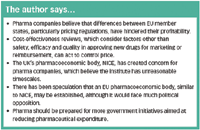EU pricing dilemmas
Pharmaceutical Technology Europe
Although representing a huge market, the EU also presents problems that hamper profitability- particularly when it comes to differing price regulations across member states.
The EU consists of 27 member states representing a population of nearly 500 million people. This offers a huge market to the pharmaceutical industry, and with Croatia, the Yugoslav Republic of Macedonia and Turkey being candidates for future membership, there will be even more opportunities for business. Despite the size of the market and a continuing demand for new medicines, however, pharmaceutical companies claim that the EU has intrinsic characteristics that hamper profitability.

Faiz Kermani
According to the European Federation of Pharmaceutical Industry Associations (EFPIA), North America accounts for close to 46% of world pharmaceutical sales compared with approximately 31% for Europe.1 The EFPIA has also highlighted that the pharmaceutical industry is the leading contributor to the EU 27 trade balance of any hightechnology sector, with approximately €38 billion contributed in 2008.1 As a result, it has been calling for the establishment of a more business-friendly environment for its member companies.
Pricing pressure
To an extent, pharma feels that it must differentiate pricing across the EU to deal with the nuances of each market, as well as to minimise profit losses that can come from countries with low sales potential. Therefore, there has never been a great desire by companies to establish a single European price for their products. Although the introduction of the euro eased business by having a common currency across a number of countries, it has also led to unexpected complications, particularly as European prices are now much more transparent to consumers and healthcare providers. Although it has always been an easy task to convert currencies, the pricing differences among member countries could previously be defended because of "currency fluctuations". It could also be argued that pricing comparisons were invalid because they depended on which rates were used for the analyses. However, such arguments can no longer be used now the euro has been established — or at least not to the same degree.
A major irritation for Europe's pharma industry is the attitude of national governments to pricing. Although governments acknowledge that a vibrant pharmaceutical sector is both beneficial and necessary, they are struggling with rising healthcare costs, which has seen them target pharmaceutical pricing as a means to drive down expenditure, much to the displeasure of pharmaceutical companies. Different member states have devised different systems to control spending. Some of the main methods include reference pricing, procedural barriers, restrictions on dispensing and prescribing, and reimbursement. In several countries, different systems may be applied depending on the type of product. While some EU countries previously only considered national aspects of the pharmaceutical market for their pricing and reimbursement decisions, it is becoming increasingly popular to incorporate information on pricing elsewhere in the EU.

The author says...
Most companies are unhappy with current pricing systems that exist across the EU because they believe they stifle their ability to innovate. Furthermore, as changes are routinely introduced by governments, companies must constantly monitor pricing systems. Unfortunately, there is no clear official guidance on how to harmonise the different pricing systems across the EU, and perhaps improve them. The EC Transparency Directive (89/105/EEC) simply states that the member states' procedures regarding the regulation of prices for medicinal products must be "based on objective and verifiable criteria" and justified accordingly.2 The Directive also sets the time limits for pricing and reimbursement decisions at a maximum of 180 days, but a number of countries have failed to meet this target. Perhaps the only positive point for the pharma industry is that the Directive also states that decisions "must be open to judicial appeal at national level".
To make matters worse for the industry, European governments have been known to impose dramatic price cuts. For example, in 2006, the Italian government decided to impose a 5% price cut on drugs used by the country's public health service, Servizio Sanitario Nazionale, to recoup money because of a 2005 spending deficit. This angered the national pharmaceutical association, Farmaindustria, which claimed that some products ended up being 40% cheaper than in other EU markets.3 Recently, the UK has experienced similar direct government intervention; in 2009, prices of prescription drugs to the UK's National Health Service were reduced by 3.9%, with an additional 1.9% price cut set for February 2010.4
A new headache
During the past decade, a new headache has emerged for companies in the form of cost-effectiveness reviews, often referred to as 'fourth hurdle requirements'. These consider factors other than safety, efficacy and quality in approving new drugs for marketing or reimbursement. Manufacturers must submit scientific dossiers and economic reports, and are increasingly being asked to show price data from other countries. Much of this information is a repeat of data used for product approval and as a result, companies consider the process to be bureaucratic and lengthy. The systems differ from country to country, but it is put in place to control product pricing; if a product is not deemed to be costeffective, pressure is placed on the company to reduce its price.
The UK was the first EU member state where this type of system had a major impact. In 1999, a pharmacoeconomic body – the National Institute for Clinical Excellence (NICE) – was established in the UK as part of the country's National Health Service (NHS). Its stated role is to provide patients, health professionals and the public with authoritative, robust and reliable guidance on current best practice. The institute conducts technology appraisals on the use of new and existing medicines, and other treatments within the NHS in England and Wales, based on a review of clinical and economic evidence.
NICE's creation was an immediate concern for pharmaceutical companies. The industry claimed that although the organisation was a good idea in principle, it had been set up with unrealistic timescales that would affect patient choice and doctors' freedom. There is still a feeling within many pharmaceutical companies that NICE guidance is premature as many companies believes that the full economic review of a drug cannot be conducted until it has been used over a period of time in a wider population than in the numbers involved in clinical trials.
Companies have frequently challenged decisions by NICE, with the support of patient groups. For example, Eisai and Pfizer challenged NICE's negative decision to ban certain anti-dementia medicines, including Eisai and Pfizer's Aricept, for NHS patients with newly diagnosed mild Alzheimer's disease — a move that has received strong backing from patient groups, such as the UK's Alzheimer's Society. The legal challenge forced NICE to reveal full details of the economic model it used to make the assessment. Subsequent independent analysis revealed the model to have errors, but NICE did not alter its ruling. As new economic data are reportedly being considered for NICE's next review, the companies have opted not to appeal and instead have asked for an expedited decision.
Will we soon see a EuroNICE?
As cost containment is a healthcare policy being pursued by many European governments, there has been speculation that an EU equivalent of NICE could be established,5 which is often referred to in the press as 'EuroNICE'. However, it is unlikely that such an organisation could be formed in the foreseeable future; one initial obstacle is politics as EuroNICE would involve redefining EU responsibilities for healthcare. Currently, healthcare is controlled by each member state's own government, but for Euro-NICE to work in the same way as the UK organisation, a European government and an EU Minister of Health would need to be established — a move that is likely to be strongly opposed by many Europeans. Even if this highly controversial step took place, there would still be numerous problems in ensuring that the EU-wide analyses yielded comparative data, because approaches to diagnosing and treating disease vary widely across the EU. When it comes to economic analyses, there is also the problem that not all member states in the EU use the euro.
With the EU constitution already having posed a problem for many European politicians, who are seeking reelection, it is highly unlikely they would suggest establishing EuroNICE, which would prove highly damaging with their electorates. There would also be technical problems in ensuring that EuroNICE could work, but the principal concern would be running healthcare policy through a central EU body.
Outlook
Although, in principle, the pharmaceutical market in Europe has grown as the EU has expanded, the pharma industry believes that the region is underperforming because of different pricing regulations and a high level of bureaucracy among member states. There is no sign that this is going to change and so companies will need to be prepared for further government interventions to drive down spending on pharmaceuticals.
Faiz Kermani is a freelance consultant and President of the Global Health Education Foundation, a charity that supports medical education and medical research projects in development countries. He is a member of Pharmaceutical Technology Europe's Editorial Advisory Board. faiz@doctors.org.uk
References
1. EFPIA, The pharmaceutical industry in Europe: key facts and figures (2008). www.efpia.org
2. European Commission, Transparency Directive 89/105/EEC (2009). http://ec.europa.
3. HIS Global Insight, National Health Service Price Cuts Rattle Drug-Makers in Italy (2007). www.ihsglobalinsight.com
4. Pharmaceutical Field Magazine, Budget's price cuts are bad news for branded pharmaceuticals (2009). www.pharmafield.co.uk
5. Anon., European Health Technology Assessment: time for Euro-NICE? Eurosante/Euro-health (2009). http://miketrem.blogactiv.eu/
